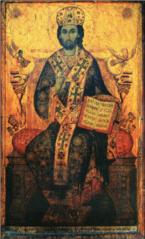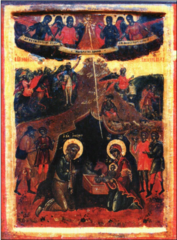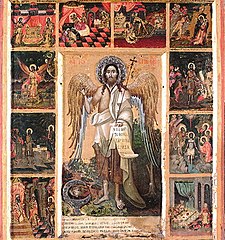Dionysios of Fourna
Dionysios of Fourna | |
|---|---|
 Virgin and Child on the Monk Pillar | |
| Born | 1670 |
| Died | 1744 |
| Nationality | Greek |
| Occupation(s) | Painter, Monk, Educator, and Author |
| Years active | 1685-1744 |
| Era | 18th Century |
| Style | Maniera Greca |
Dionysius of Fourna (
Biography

He was born in
He painted several
He wrote his manual on painting from 1728-1733 with the help of his student Kyrillos Foteinos. The book was widely distributed in the Balkans.
It is likely that Dionysius surveyed existing churches from the medieval period, where the life of Christ would be told in emblems around the church. Although the work is not original, nor designed to be original, the description of each scene is probably from Dionysius's own imagination and imagery.
Gallery
-
Christ Enthroned
-
Anastasis Athos
-
Nativity of Christ Athos
-
From the Cell of Dionysios at Mount Athos John the Baptist and a Narrative of His Life
-
Young Jesus
Literary works
- Interpretation of Painting Art (Ερμηνεία της Ζωγραφικής Τέχνης)[7]
References
- ^ Hatzidakis 1987, pp. 102, 108, 123.
- ^ Hatzidakis & Drakopoulou 1997, pp. 219, 291, 292, 452–453.
- ^ University of California (July 3, 2022). "Dionysius of Fourna: Artistic Identity Through Visual Rhetoric". Mateusz Ferens. Retrieved June 3, 2022.
- ^ Search Greek Culture (July 3, 2022). "Dionysius of Fourna". Staff Writers. Retrieved June 3, 2022.
- ISBN 9789080647688.
- ^ a b Hatzidakis 1987, p. 123.
- ISBN 9780950316307.
Bibliography
- Hatzidakis, Manolis (1987). Έλληνες Ζωγράφοι μετά την Άλωση (1450-1830). Τόμος 1: Αβέρκιος - Ιωσήφ [Greek Painters after the Fall of Constantinople (1450-1830). Volume 1: Averkios - Iosif]. Athens: Center for Modern Greek Studies, National Research Foundation. ISBN 960-7916-01-8.
- Hatzidakis, Manolis; Drakopoulou, Evgenia (1997). Έλληνες Ζωγράφοι μετά την Άλωση (1450-1830). Τόμος 2: Καβαλλάρος - Ψαθόπουλος [Greek Painters after the Fall of Constantinople (1450-1830). Volume 2: Kavallaros - Psathopoulos]. Athens: Center for Modern Greek Studies, National Research Foundation. ISBN 960-7916-00-X.
- Brubaker, Leslie. "Dionysius of Fourna" in Strayer, Joseph R. ed. Dictionary of the Middle Ages. New York: Charles Scribner's Sons, 1984. vol. 4, pp 191-2.
- Van Ginkel, J., Paul Hetherington, and A. N. Palmer. "Dionysius of Fourna" in Turner, Jane ed. The Grove Dictionary of Art. New York: Grove Dictionaries, 1996. vol. 18, p. 910.
- (in Greek) The greek text of the 'Interpretation of Painting Art (Ερμηνεία της Ζωγραφικής Τέχνης)', edited by Papadopoulos-Karemeos, 1909
- (in French) French translation of the 'Painter's Manual', edited by Didron, 1845





